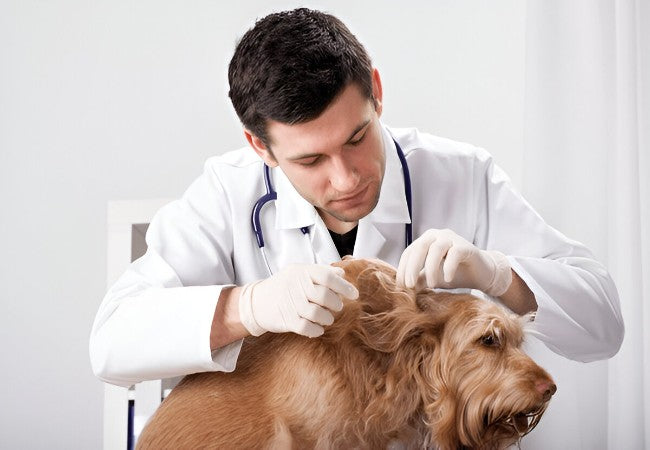Veterinary Guide to Canine Pediculosis (Lice) 2025 🐶🩺

In this article
Veterinary Guide to Canine Pediculosis (Lice) 2025 🐶🩺
By Dr. Duncan Houston BVSc
🧬 What Is Pediculosis?
Pediculosis, or lice infestation, in dogs involves small, wingless insects living on the coat and skin. Two main types occur:
- Chewing/biting lice (Trichodectes canis, Heterodoxus spiniger): consume skin debris and cause irritation. Some species can transmit the tapeworm Dipylidium caninum.
- Sucking lice (Linognathus setosus): feed on blood, can lead to anemia in severe cases.
Lice are host-specific, meaning canine lice don’t infest humans or cats.
⚠️ Who Is at Risk?
- Puppies, senior dogs, or immunocompromised dogs.
- Neglected, stray, or overcrowded dogs.
- Long-haired breeds are more susceptible to heavy infestations.
- Dogs in kennels, show venues, or day-care settings.
👀 Clinical Signs
- Severe itchiness, scratching, rubbing, restlessness.
- Rough, dull or matted coat; dry skin; possible fur loss.
- Wing or military bleeding, anemia signs if sucking lice are heavy in young or small dogs.
- Nits (eggs) clinging to hair shafts; often mistaken for dandruff.
- Possible secondary bacterial infections from scratching.
🔍 Diagnosis
- Visual exam—part coat and look for adult lice or nits (~2–4 mm, light brown/grey, slow-moving).
- Use a fine-toothed flea comb to collect lice or eggs; contrast on white paper helps.
- Skin scraping or acetate tape test to differentiate from mites or fleas.
🛠️ Treatment
Effective eradication combines direct parasite removal, topical or systemic insecticides, and environmental control.
• Topical Spot‑Ons & Dips
- Fipronil, imidacloprid, selamectin: proven lice killers, often in flea/tick preventatives.
- Permethrin, pyrethrins: effective shampoos, sprays—but use permethrin only for dogs, never cats.
- Isoxazolines (fluralaner, afoxolaner): single dose may suffice; veterinary Partner notes need only 1–2 doses.
• Shampoos, Dusts & Collars
- Insecticidal shampoos containing pyrethrins provide rapid relief.
- Dusts/sprays for bedding and surroundings are recommended by Merck.
- Collars (e.g., propoxur)—mostly obsolete; spot‑ons currently preferred.
• Re-treatment & Grooming
- Repeat treatment 7–10 days after the first to catch hatching eggs.
- Bathroomly groom with a flea comb to physically remove lice & nits.
- Clip heavily matted coats as needed.
• Addressing Anemia
- Severe sucking lice infestations—especially in puppies—may need iron/vitamin supplementation.
- Monitor hematocrit in serious cases.
🏡 Environmental Control & Prevention
- Wash bedding, blankets, collars, brushes with hot water; treat pet’s environment.
- Treat all in-contact dogs—even asymptomatic ones—to prevent reinfestation.
- Maintain regular flea/tick prevention year-round—most prevent lice too.
- Keep dog environments clean, well-groomed, and avoid overcrowding.
📈 Prognosis
- Excellent with proper treatment and environmental control.
- Chronic infestations in neglected dogs require multiple treatments and close follow-up.
- Anemia and secondary infections resolve with supportive care.
📱 Ask A Vet Telehealth Support
- 📸 Owners share grooming photos or video of lice/eggs for remote review and treatment advice.
- 🔔 Reminders for treatment schedule, grooming tasks, and environmental cleaning.
- 🩺 Virtual consults to assess coat condition, skin healing, and scratching behavior.
🎓 Case Spotlight: “Milo” the Maltese
Milo, a 10-week-old Maltese puppy, had intense scratching and flaky skin. Chewing lice were identified via combing. Treatment included spot-on selamectin, follow-up after 10 days, environmental cleaning, and comb-out twice weekly. Ask A Vet helped monitor improvements.🐾
🔚 Key Takeaways
- Pediculosis in dogs includes both chewing and sucking lice, diagnosed visually with comb and examination.
- Treat with proven topical/systemic options: fipronil, imidacloprid, selamectin, permethrins, or isoxazolines.
- Repeat treatment after 7–10 days and groom combs to remove live lice/nits.
- Environmental cleaning and treating all in-contact pets reduce reinfestation.
- Prognosis is excellent with timely, comprehensive management.
- Ask A Vet telehealth supports diagnosis, treatment scheduling, remote assessment, supply delivery, and progress tracking 🐾📲
Dr Duncan Houston BVSc, founder of Ask A Vet. Download the Ask A Vet app for expert telehealth help—from lice detection and treatment guidance to grooming instruction, supply coordination, and long-term monitoring for your dog’s skin wellness 🐶📲






